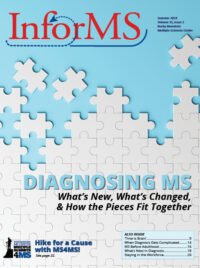By Thomas Stewart, M.S., J.D., PA-C | The Americans with Disabilities Act (ADA) is the primary protection provided to workers with disabilities who want to stay in the work force. The ADA was passed “to provide a clear and comprehensive national mandate to end discrimination against individuals with disabilities and to bring persons with disabilities into the economic and social mainstream.”
The ADA is federal law, enforced by the Equal Employment Opportunity Commission (the “EEOC”), that protects virtually all disabled employees, as long as their employer has at least 15 employees. In the context of the ADA (but not for other purposes, such as Social Security Disability law), a person who is disabled “has a physical or mental impairment that substantially limits a major life activity.” This impairment must be substantial in that the impairment “significantly limits or restricts a major life activity such as hearing, seeing, speaking, breathing, performing manual tasks, walking, caring for oneself, learning or working.”
Critically, the Americans with Disabilities Act requires that covered employers make “reasonable accommodations to the known physical or mental limitations of an otherwise qualified individual with a disability.” Surprisingly, the critical words “reasonable accommodation” are not defined within the ADA. Rather, a few examples are provided, including making physical changes to render facilities accessible, restructuring jobs, offering part-time or modified work schedules, offering to reassign, modifying existing equipment or acquiring new equipment, and providing interpreters.
An excellent resource for identifying potentially useful accommodations can be found at the website of the Job Accommodation Network (JAN). JAN is organized in multiple ways, including by diseases, such as multiple sclerosis. It is then further organized by particular symptoms and limitations.
For example, for the many people with MS who experience fatigue, JAN offers the following possible suggestions, cut and pasted from their website: [su_list icon=”icon: circle”]
- Aide/Assistant/Attendant
- Anti-fatigue Matting
- Elevating Wheelchairs
- Ergonomic Assessments
- Ergonomic Equipment
- Flexible Schedule
- Job Restructuring
- Periodic Rest Breaks
- Scooters
- Stand-lean Stools
- Telework, Work from Home, Working Remotely
- Walkers
- Wearable Anti-fatigue Matting
- Wheelchairs
- Worksite Redesign / Modified Workspace
Each of these suggestions is further described. For example, for flexible schedule, the website elaborates:
“Employees who experience certain limitations may need a flexible schedule in order to work optimally during hours of increased attentiveness. Flexible schedules can also be used to have a period of mental rest in order to refocus and reorient into his/her work. Examples of a flexible schedule would be adjusting starting and ending times of the workday, combining regularly scheduled breaks to create one extended break or dividing large breaks into smaller segments, and allowing work to be completed during hours when the employee is most mentally alert.”
To begin the process of seeking reasonable accommodations, the person with a disability must inform the employer that, due to a medical condition, there is a need for an adjustment, accommodation or change at work. No legalese (for example, “I hereby request an accommodation”) is necessary – only in plain English.
A request for an accommodation should trigger an “interactive process,” which refers to the information-gathering necessary to evaluate the request for accommodation. As described by the EEOC, the interactive process “is intended to be a flexible approach that centers on the communication between an employer and the individual requesting reasonable accommodation, but may (and often does) involve obtaining relevant information from a supervisor and an individual’s health care provider.” The person who will decide whether to grant or deny a reasonable accommodation will engage in a discussion with the employee with a disability as well as others (such as a supervisor, or health care provider), to collect information about whether there are accommodations that can be made that will eliminate any barriers to employment.
There is only one statutory limit on whether a particular accommodation is reasonable. An employer need not accommodate an employee with a disability if doing so would cause the employer “ undue hardship.” “Undue hardship”, according the EEOC, refers to “significant difficulty or expense and focuses on the resources and circumstances of the particular employer in relationship to the cost or difficulty of providing a specific accommodation. Undue hardship refers not only to financial difficulty, but to reasonable accommodations that are unduly extensive, substantial, disruptive, or those that would fundamentally alter the nature or operation of the business.” Whether an accommodation would create an undue burden for an employer is usually specific to each situation.
Another consideration that may restrict a request for an accommodation is that an employee – with or without an accommodation – must be able to perform the essential functions of the position. For example, if an employee cannot meet the production goals of a position, even with an accommodation, he or she may not be protected by the ADA.
There are three factors to consider when evaluating a function as essential or marginal: [su_list icon=”icon: circle”]
- The relationship of the functions to other tasks within the job,
- Whether reassigning the functions will affect other employees and their jobs, and
- The significance of the function and the conditions under which it is performed.
For example, assume that someone is employed operating a machine. The job description, among other things, states that the job includes “painting the machine twice a month.” However, painting the machine may not be an essential function because it is not critical to the execution of the job, which is to operate the machine.” Accordingly, a request by the machine operator to have the painting function assigned to another worker might be granted as a reasonable accommodation.
If you have requested an accommodation that has been disapproved of by your employer, the next step may be to call the EEOC. To enforce rights under the ADA, you must file a Charge of Discrimination with the EEOC before filing a job discrimination lawsuit against your employer. There are time limits for filing a charge – generally 180 days from the date of the alleged violation. You may be entitled to hiring, promotion, reinstatement, back pay, or reasonable accommodation, including reassignment, and possibly attorney’s fees.
While the EEOC can only process ADA charges based on actions occurring on or after July 26, 1992, you may already be protected by State or local laws or by other current federal laws. EEOC field offices can refer you to the agencies that enforce those laws.
To contact the EEOC, you can call (800) 669-4000.
Thomas Stewart directs the RMMSC’s Disability Law Program. For a free consultation, please contact RMMSC’s Disability Law Clinic at (720) 301-9708.
References:
Much of the above is drawn from the website of the EEOC, www.eeoc.gov.
Also, as mentioned above, much was drawn from the website of the Job Action Network: https://askjan.org/
P.C. Grant (1997, March-April Busness Horizons), “Essential or marginal? Job functions and the Americans with Disabilities Act.”






